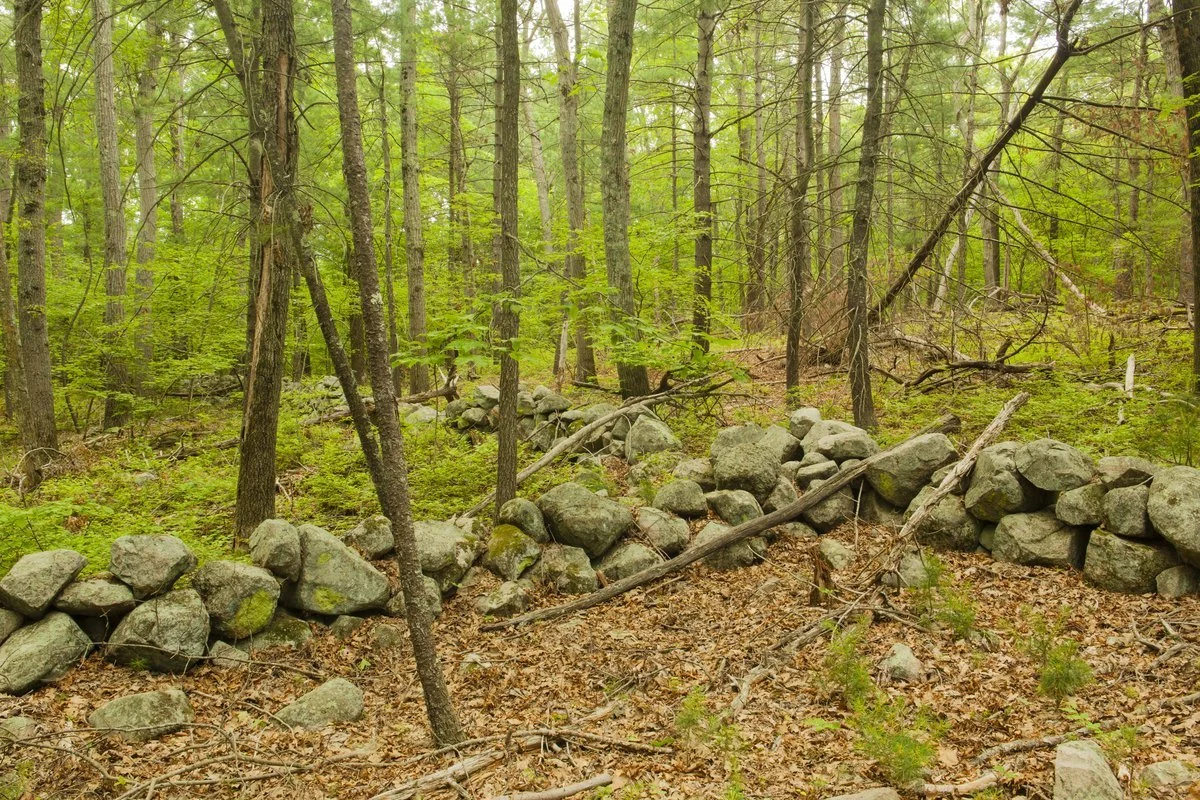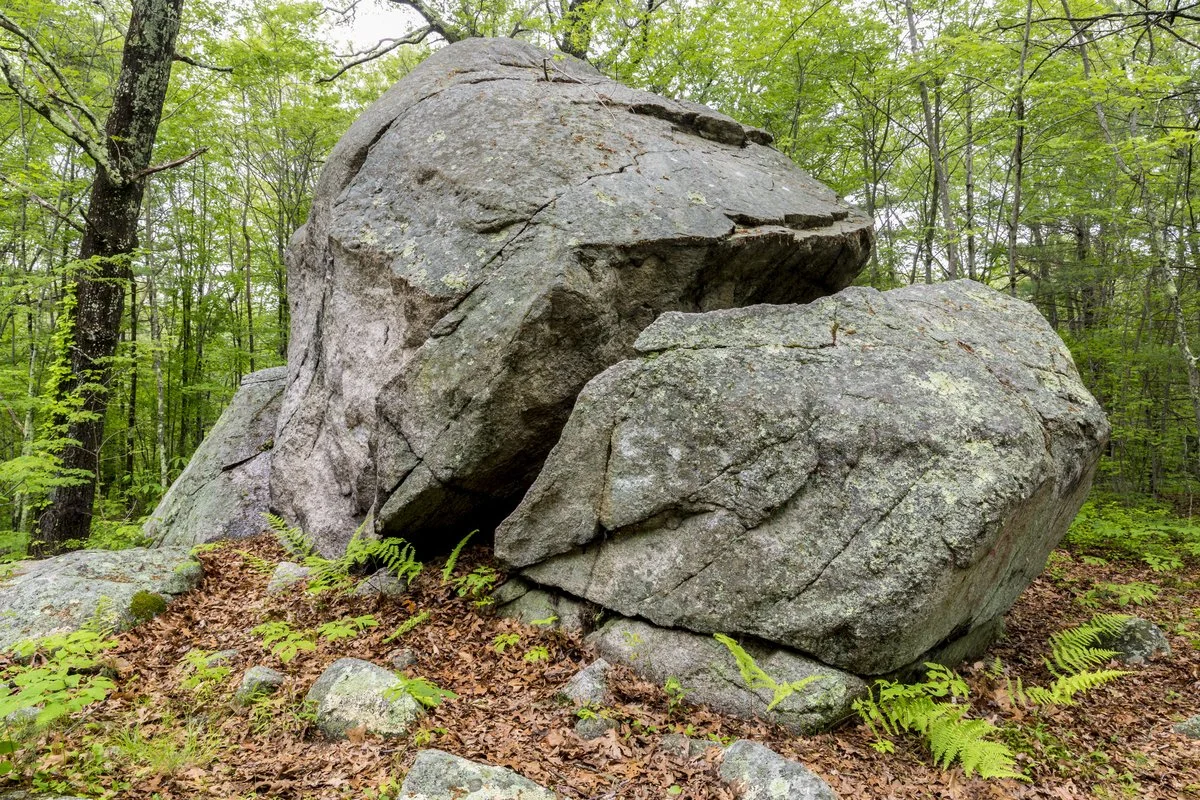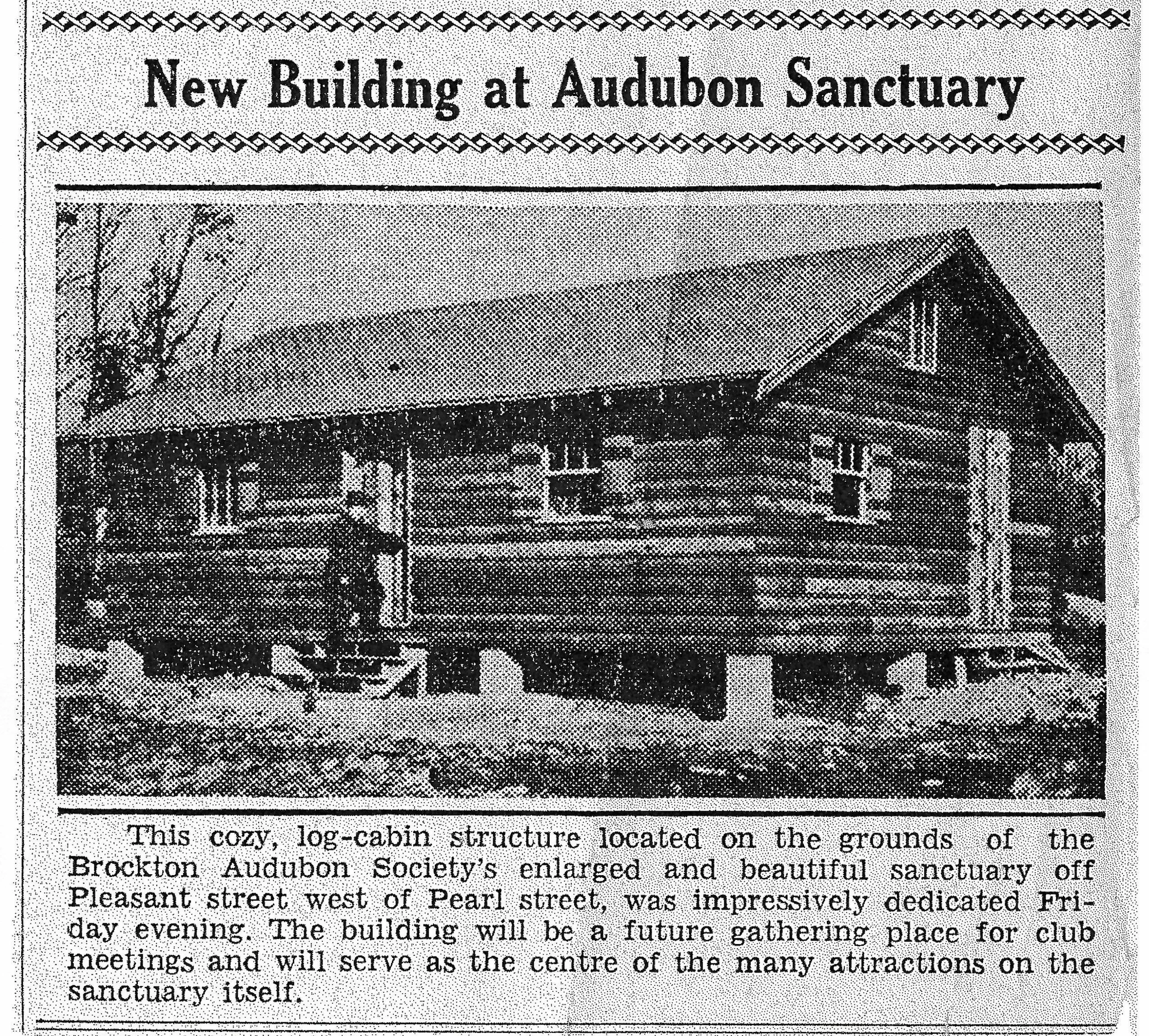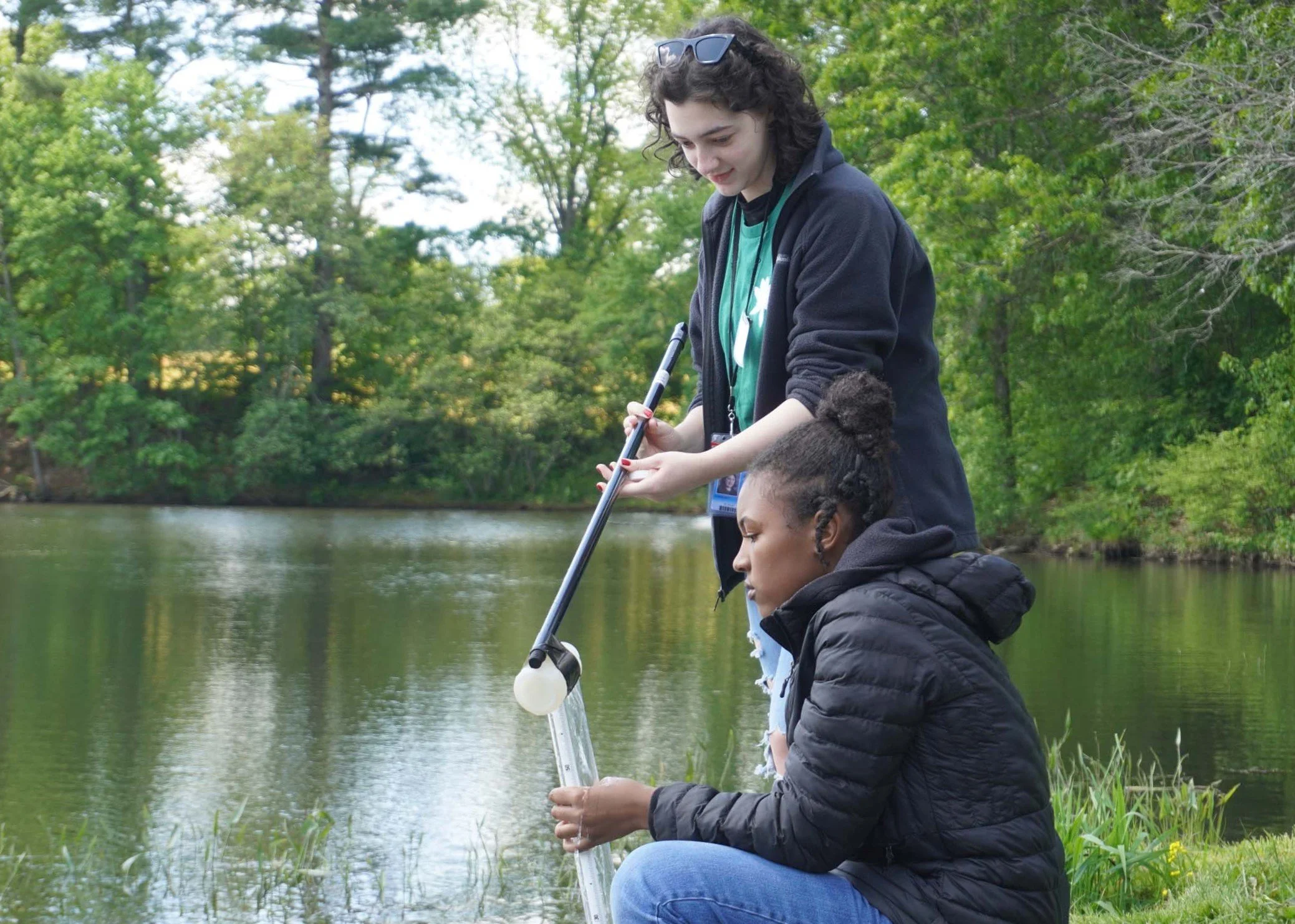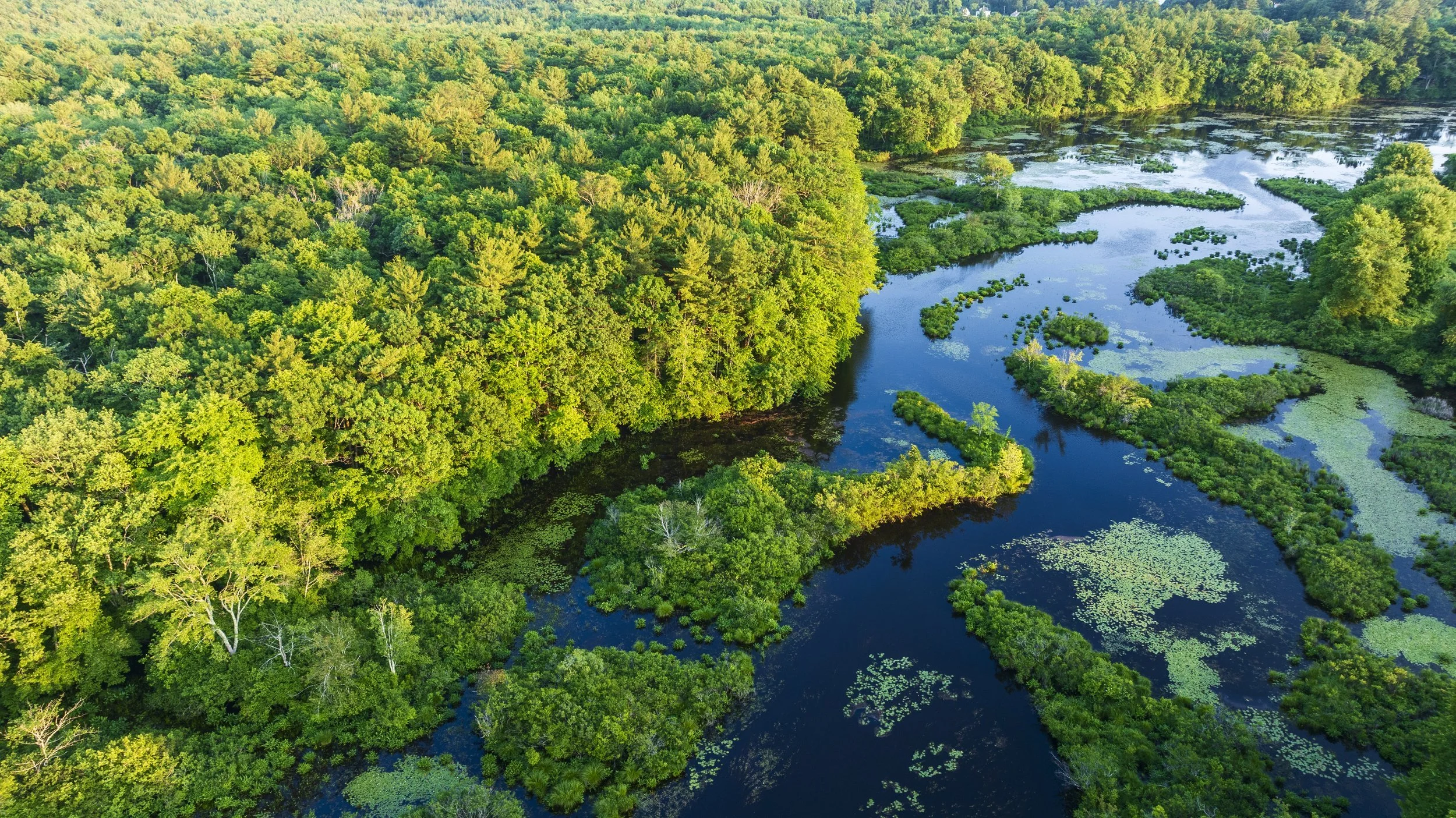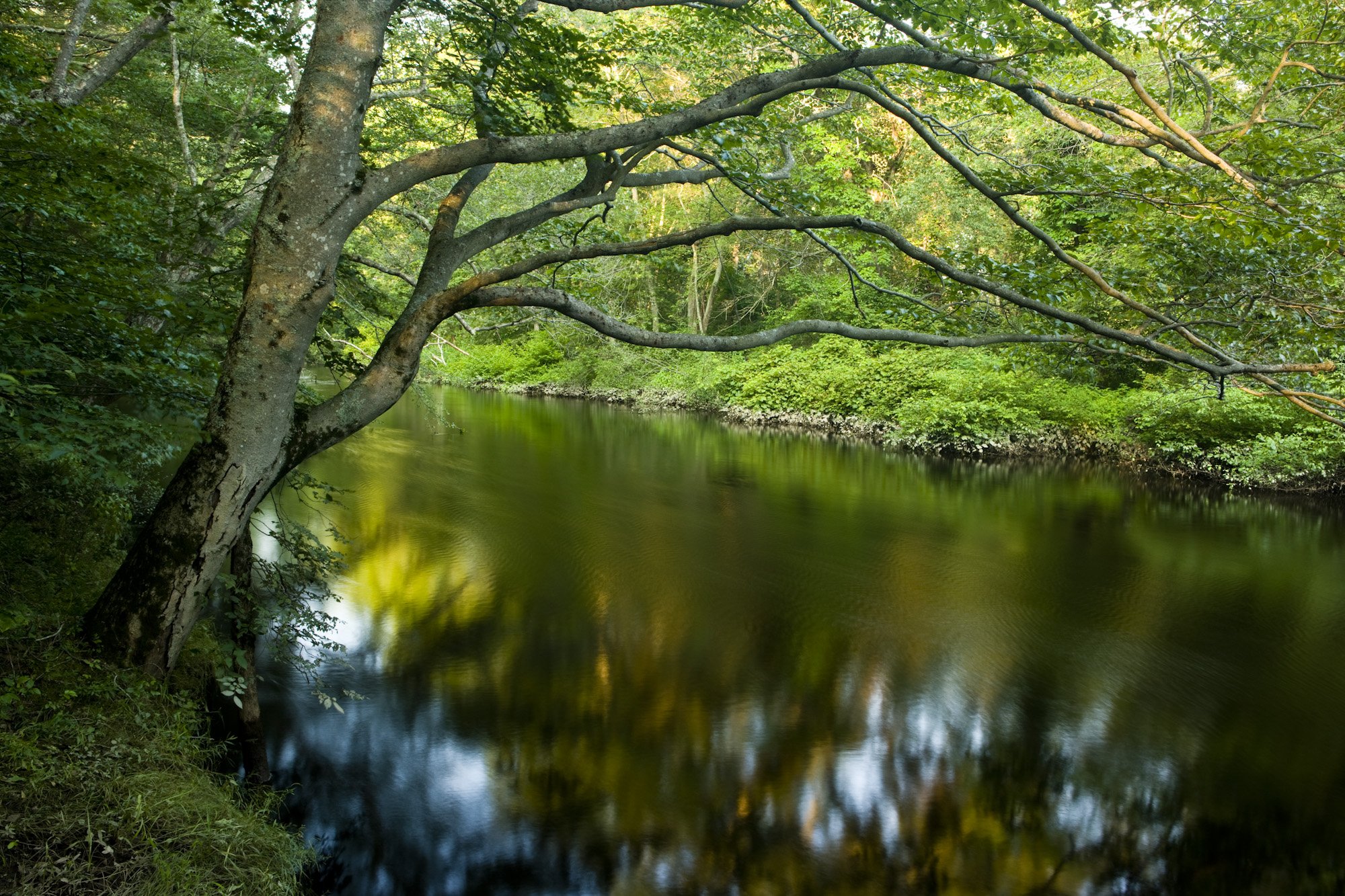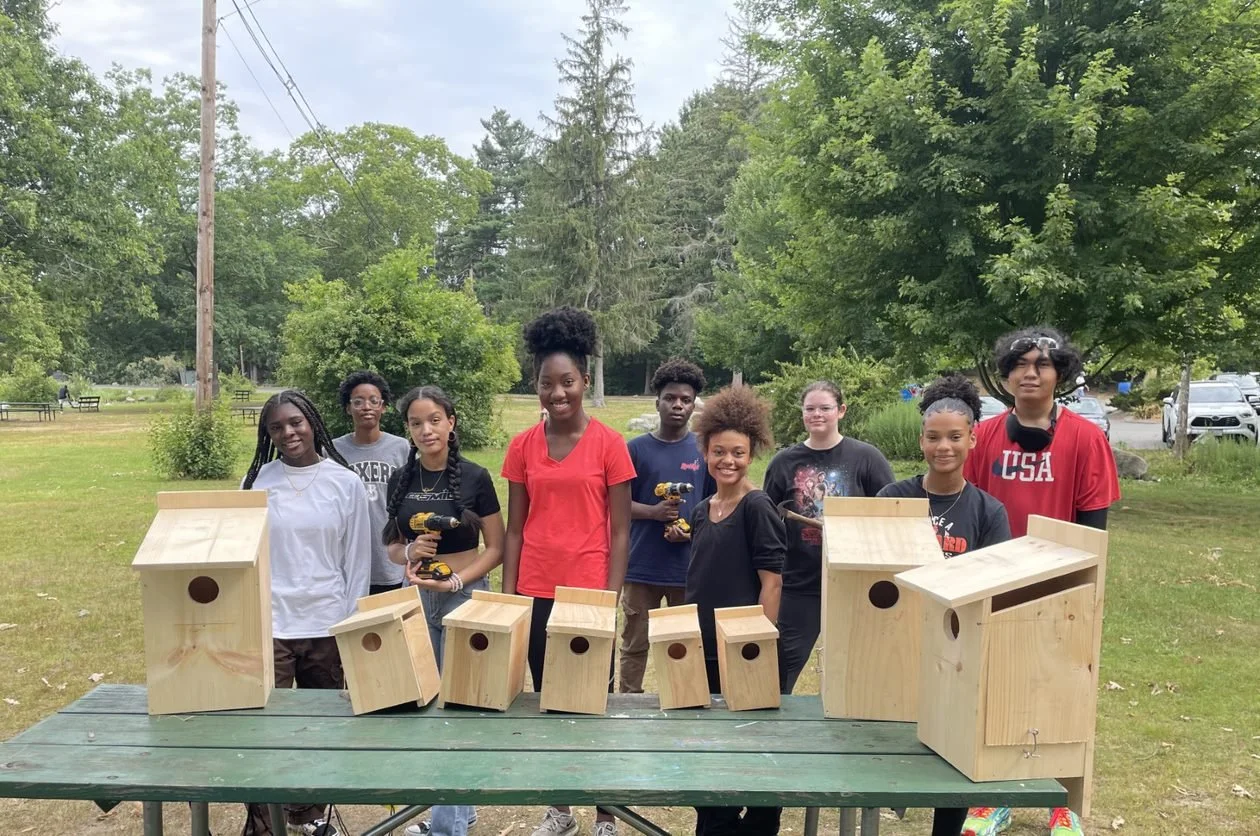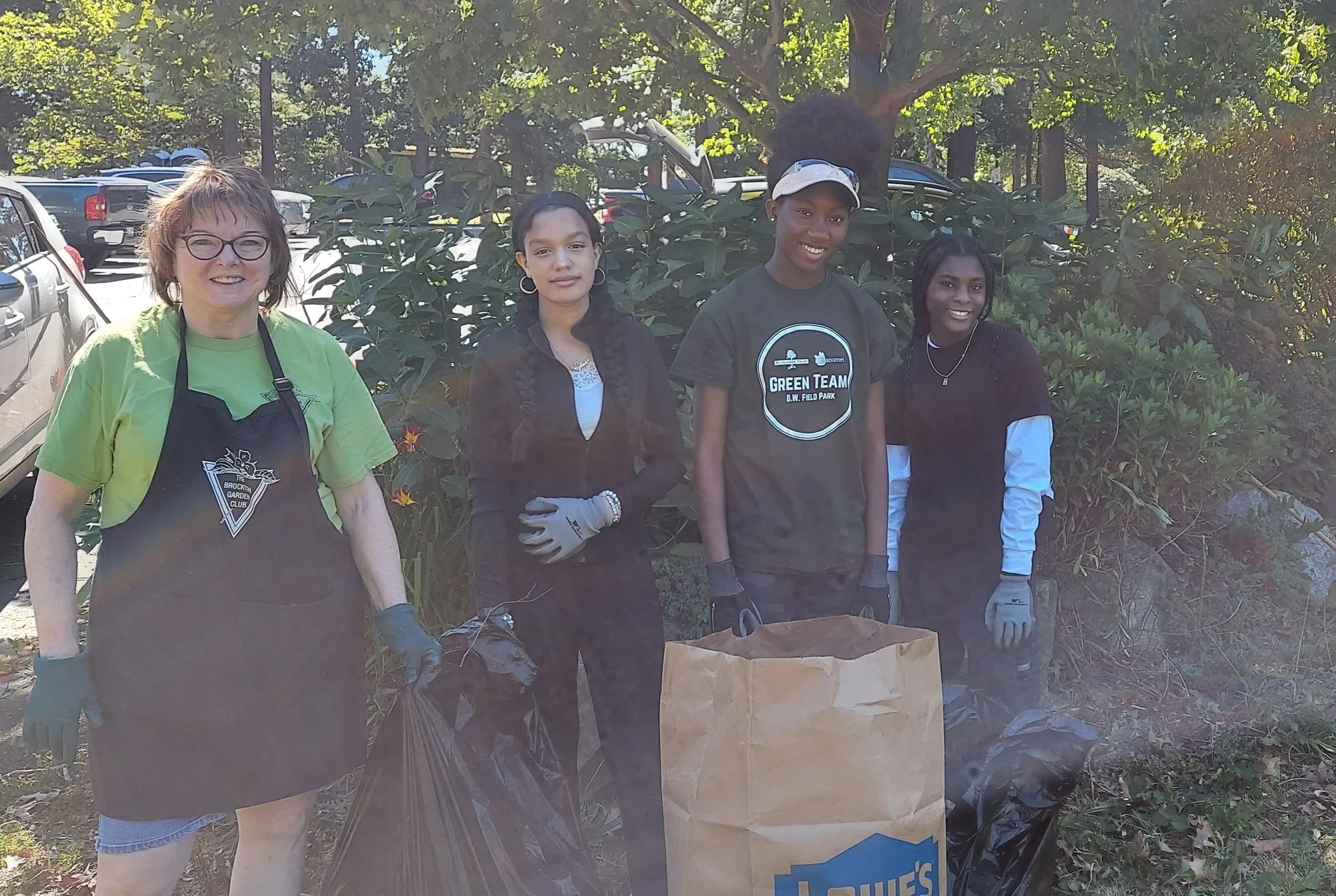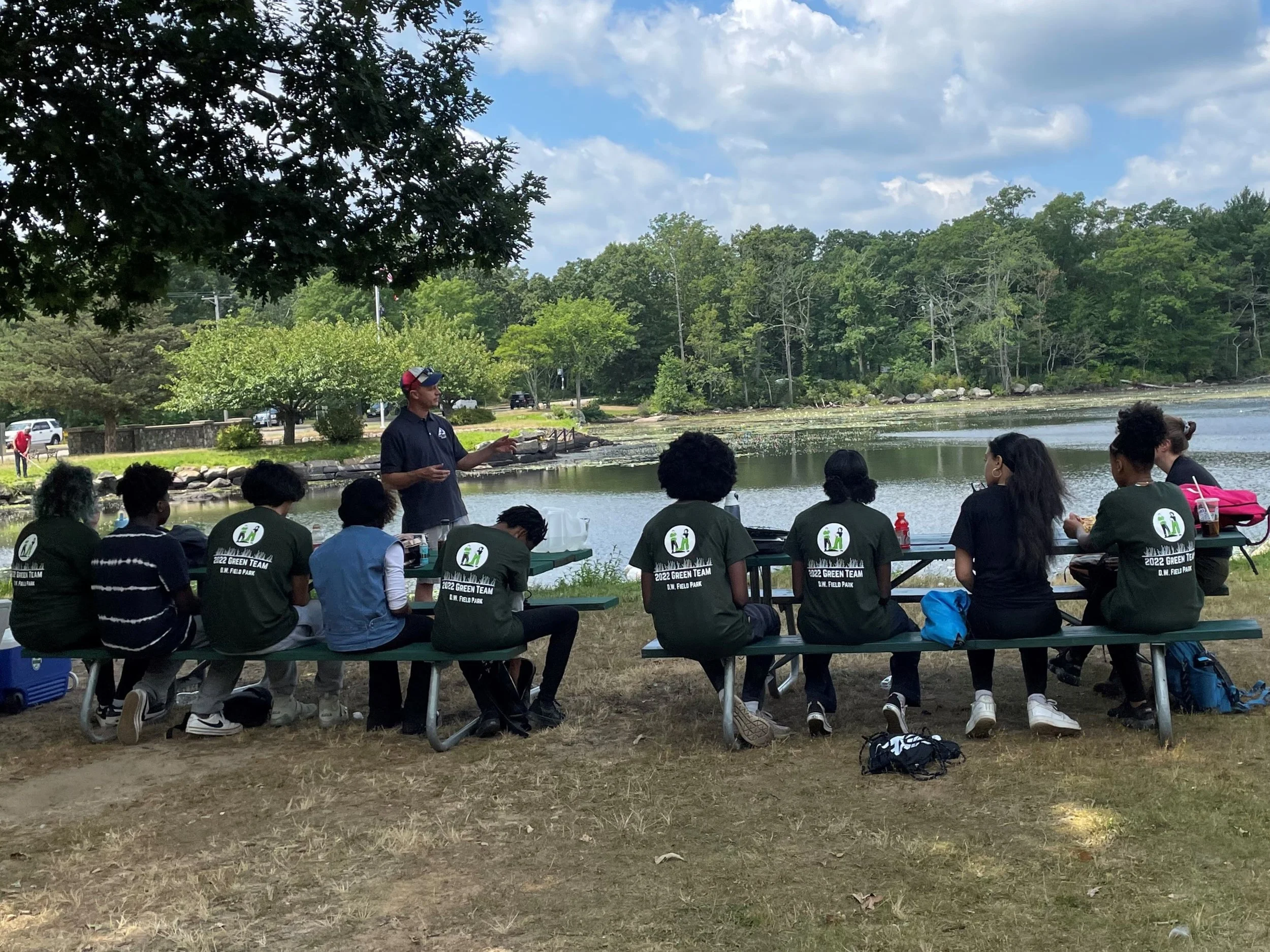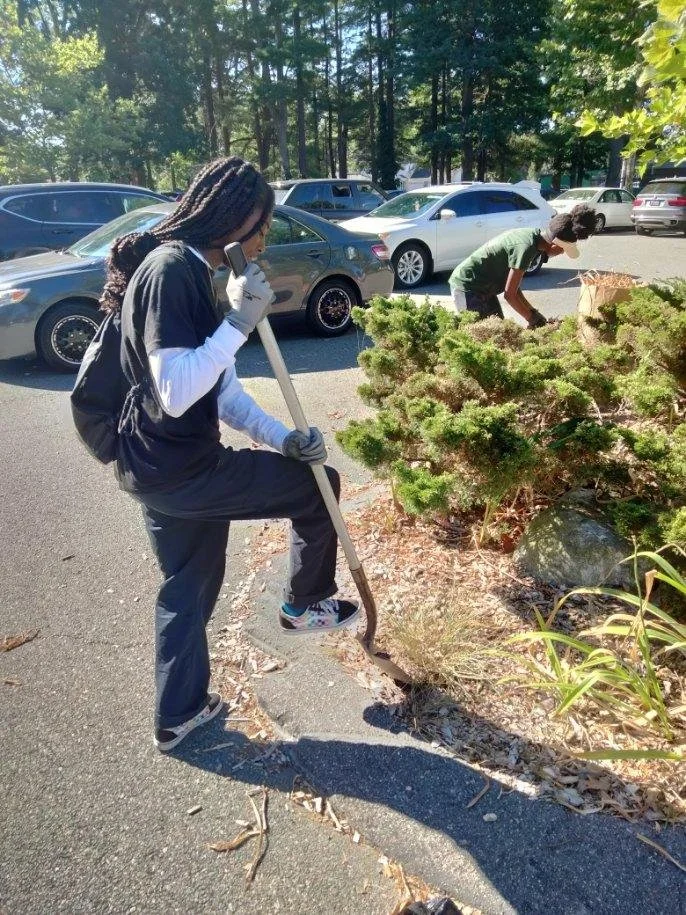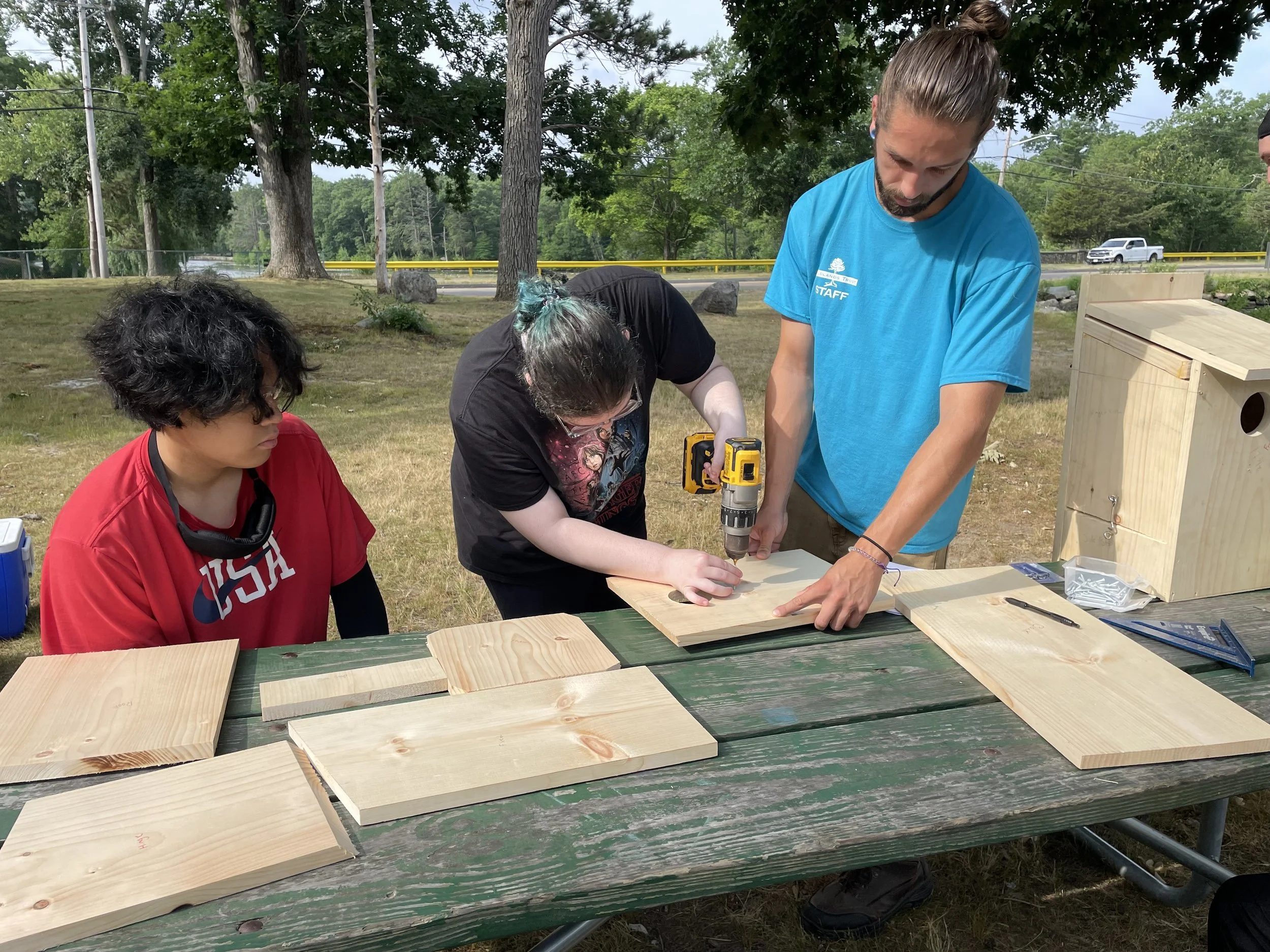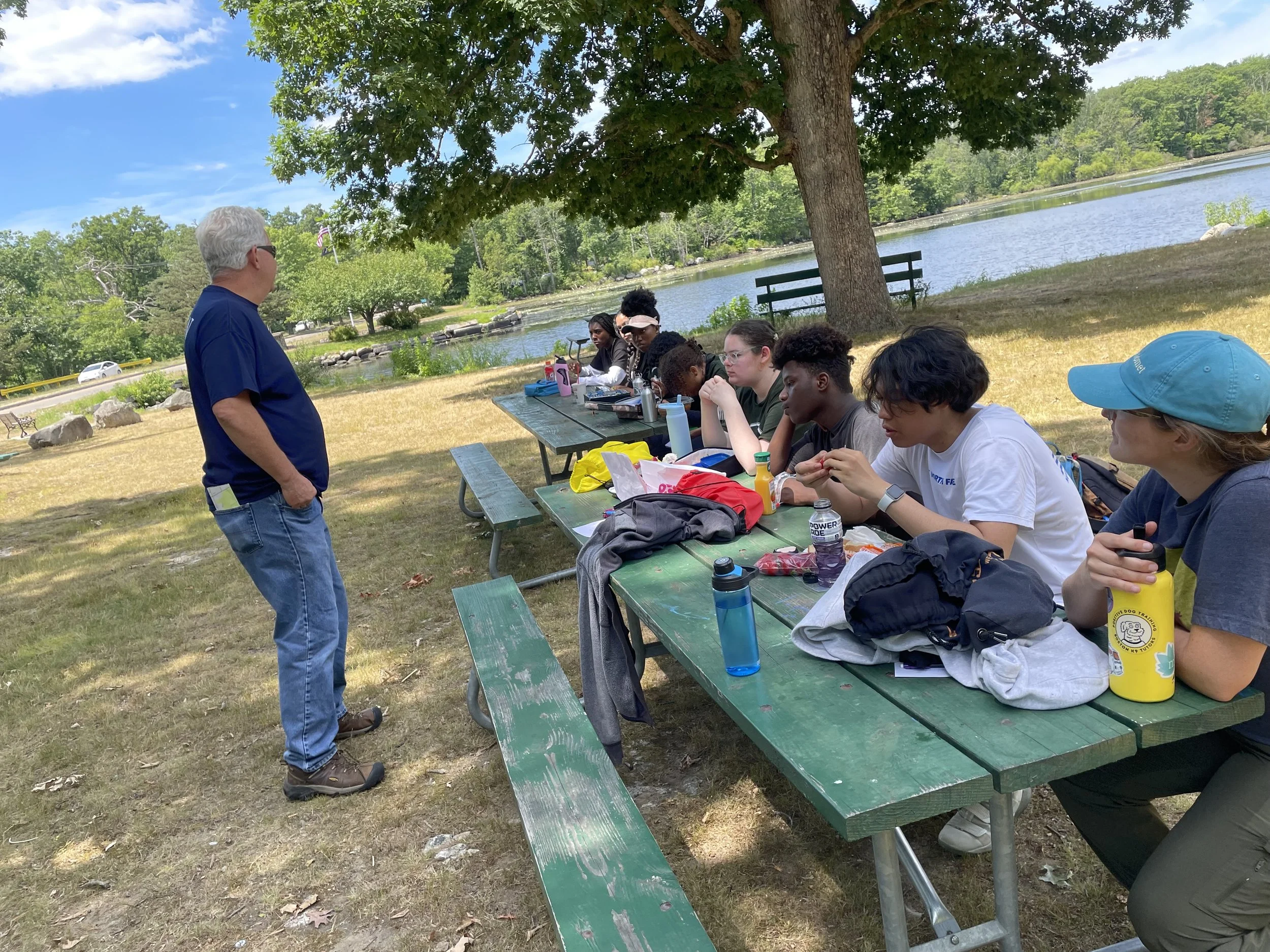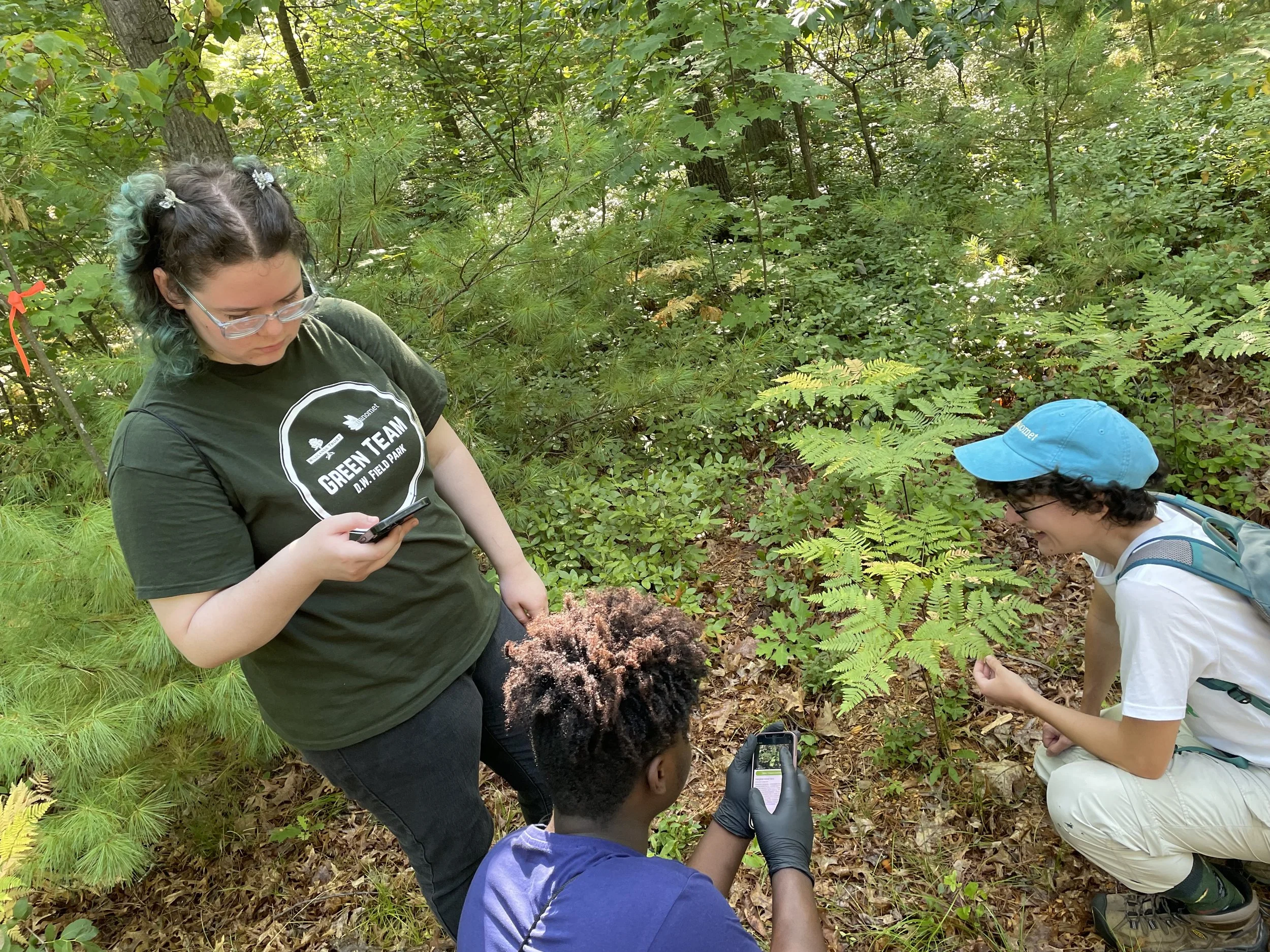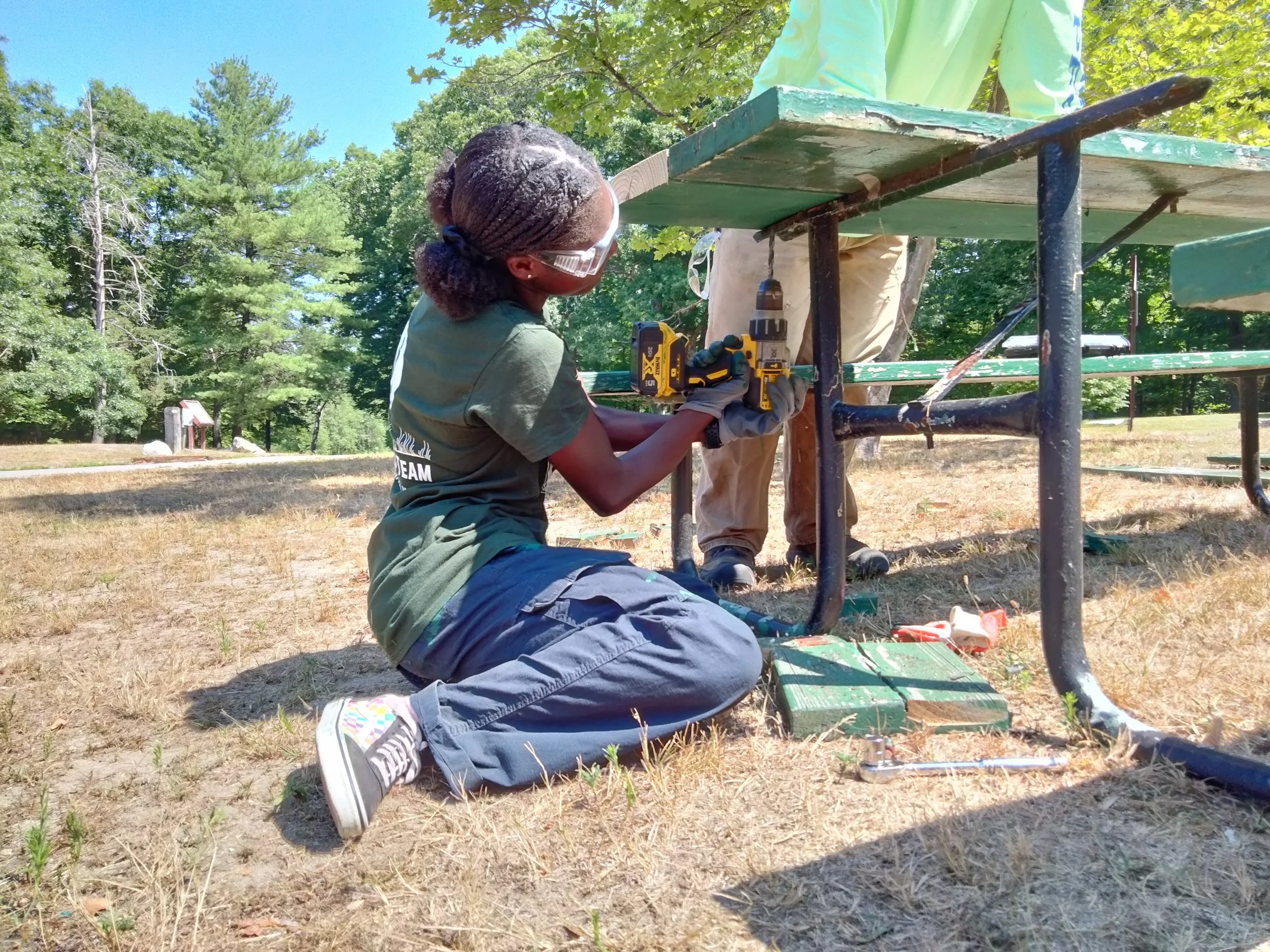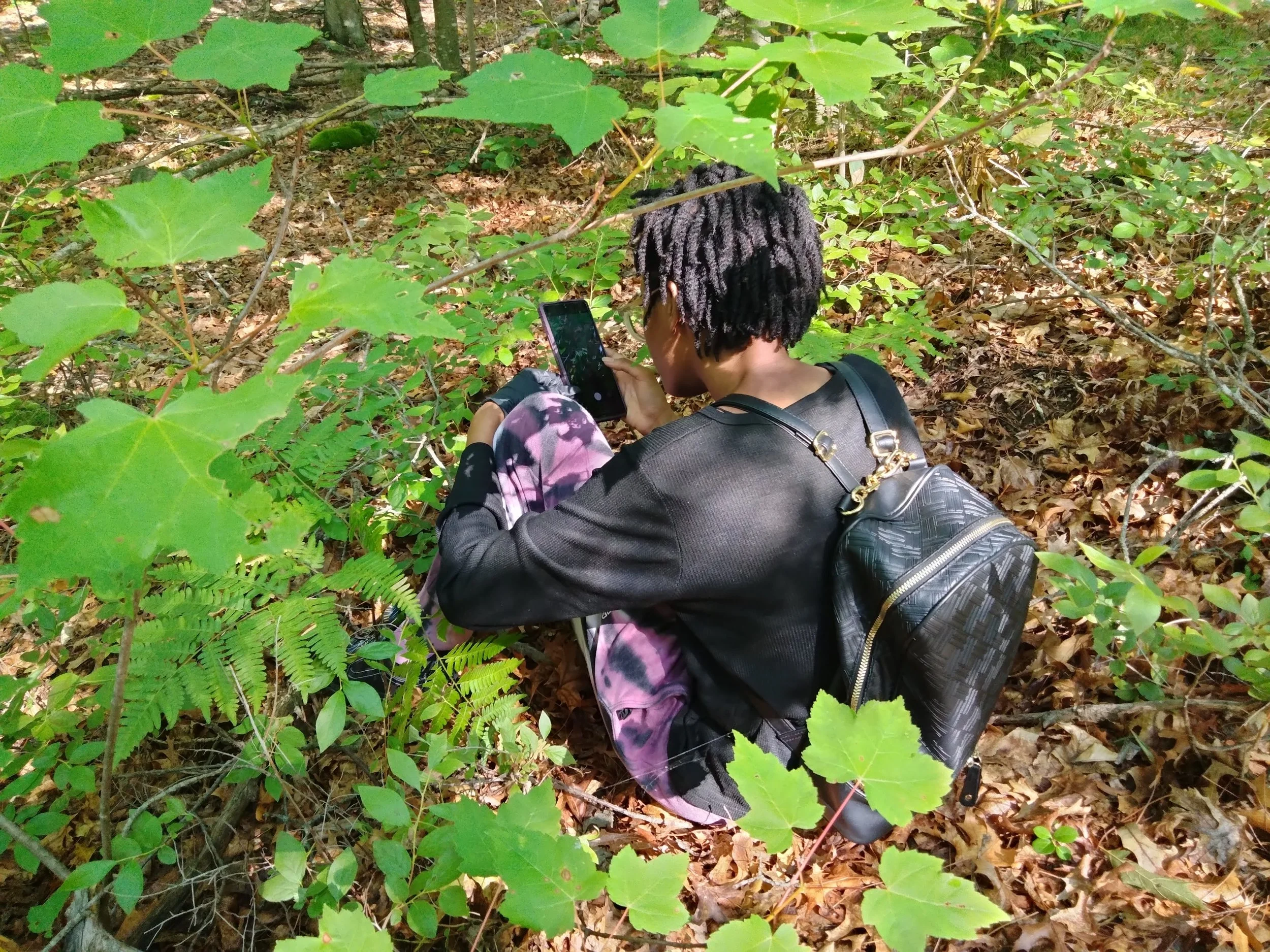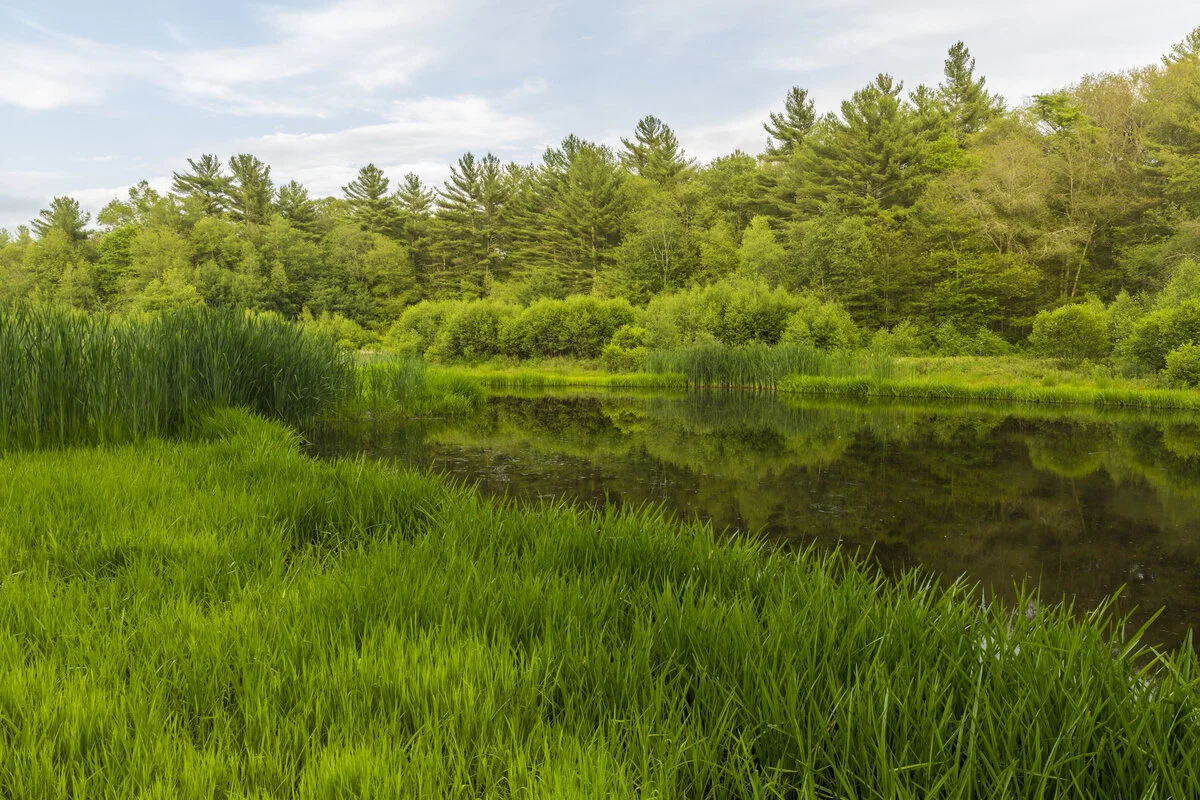What’s New at Wildlands
Human History of Wildlands: Brockton Preserves
Stone walls traverse the woods at Brockton Audubon Preserve. Photo by Jerry Monkman.
By Skip Stuck, Key Volunteer
Back in 2018, Wildlands Trust President Karen Grey addressed an audience of land conservation professionals, town conservation commission members, and volunteers at the Southeastern Massachusetts Land Trust Convocation. Though Karen spoke broadly about Wildlands’ land protection, stewardship, and education initiatives, most of the audience’s questions and comments came when Karen described Wildlands’ activities in the city of Brockton. It was clear that many listeners were surprised that Wildlands would invest so much time and effort in the state's sixth-largest city of over 105,000 residents. Karen asserted that land conservation is an important goal anywhere, and perhaps even more so in a city where natural and recreational resources are limited.
To help a city reconnect with its long-lost natural resources, we first need to understand its history. How have humans altered the landscape over time? What exactly has been lost? Only by knowing an area’s past can we begin to repair its future.
Wildlands is lucky enough to work with someone who has witnessed Brockton’s history firsthand, who can share local stories that might otherwise have been forgotten. Since 2020, Frank Moore has protected his 20-acre farm and forest property in East Bridgewater through a Conservation Restriction (CR) with Wildlands. But in the 1930s and ‘40s, Mr. Moore spent his childhood in Brockton, where the lands of present-day Stone Farm Conservation Area and Brockton Audubon Preserve served as his “playgrounds.” In April 2024, Wildlands Land Protection Assistant Tess Goldmann and Communications Coordinator Thomas Patti visited Mr. Moore at his East Bridgewater home to hear his many stories from growing up on these lands. Mr. Moore’s encyclopedic knowledge of the area was crucial to my research for this piece.*
If you, like Mr. Moore, have oral, written, or photographic accounts to share pertaining to the natural or cultural history of Southeastern Massachusetts, we would love to hear from you. What may seem to you like trivial stories might be pivotal to our understanding of the places we strive to protect—and to our very ability to protect them.
Please contact Communications Coordinator Thomas Patti at tpatti@wildlandstrust.org to share your stories.
Glacial erratic at Brockton Audubon Preserve. Photo by Jerry Monkman.
Brockton’s Beginnings
Brockton lies within the Taunton River Watershed, the history of which I explored this spring. The area has a 10,000-plus-year history of habitation by native peoples, most recently members of the Wampanoag Tribe. Their population thrived, creating one of the most densely populated areas of local native settlement. According to the Wampanoag Tribe, the areas that now includes Brockton Audubon Preserve and Stone Farm Conservation Area also had religious significance, as evidenced by the rearrangement of some of the many glacial erratic boulders into formations that align with astronomical events, such as the daily and annual path of the sun through the sky.
However, in the early 1600s, exposure to disease brought by European trappers and fishermen—even before the 1620 arrival of the Pilgrims—decimated the local population by as much as 80 percent.
Then Plymouth Colony was founded, and within 20 years it had out-grown its initial settlement. In 1649, Massasoit, sachem of the Wampanoag Tribe, sold the land then known as Saughtucket to Myles Standish. It was renamed to Bridgewater, and again to North Bridgewater in 1821. The area thrived as a farming and forestry community until the mid-1800s. During the years leading up to the Civil War, the area was a well-known stop on the Underground Railroad, helping runaway slaves reach safety in New England and Canada.
But rapid change was coming. The end of the Civil War accelerated the westward migration of farmers out of New England. The Industrial Revolution was taking over, and farmers were soon replaced by immigrants from Europe and beyond, drawn by jobs in the burgeoning textile and shoemaking industries. The rapidly growing town was reincorporated as a city in 1881 and given its current name of Brockton in 1884. Interestingly, the name came from Sir Isaac Brock, a British officer in the War of 1812, who had no connection whatsoever to the town. Who'd figure?
From the Brockton Daily Enterprise, April 3, 1937. “With the near completion of improvements to the new sanctuary, located off Pleasant street, the Brockton Society has one of the finest wild-life conservation areas in this section of Massachusetts. … [It] contains a diversified terrain suitable for a variety of birds and plants.” Clipping courtesy of Frank Moore.
Progress Spurs Preservation
Brockton was headed for the big time. In 1883, it gained the first municipal AC electrical power system in the world, with the first switch pulled by none other than Thomas Edison. By 1900, over one-third of Brockton’s male population was employed in the shoe industry. Growth was changing the character of Brockton. Land was developed for industry, and housing was rapidly replacing the wetlands, farms, and fields of 50 years earlier.
Wildlands Trust was not the first organization to recognize the need for environmental protection and education in Brockton. In 1919, Amelia Brown and 88 others came together to found the Brockton Audubon Society, with a mission to save wooded areas and the wildlife within them. In 1921, the Society purchased 23 acres from Martin Packard to create the first Brockton Audubon Preserve. In 1937, they added 39 acres and built a log cabin-style building known as the Clubhouse to use as a headquarters and a site for picnics and special events. In the following years, the Society, under the leadership of Brockton tree warden Rufus Carr, obtained additional parcels to bring the preserve to its current 128 acres. For many years, the land provided a beautiful and popular resource for the community. However, as the founding Society members grew older, its membership shrank, and caring for the property grew difficult. In 2011, the remaining members voted to donate the land to Wildlands Trust to ensure its permanent protection.
Adjacent to the Brockton Audubon Preserve was a City-owned tract of 105 acres known as Stone Farm Conservation Area. Over the years, this land witnessed many changes, as well. At various times, it has been a pasture, a timber plantation (until the 1938 hurricane leveled all of the pines), a horse farm, and an ice pond with an ice house. It has been the site of a Brockton police firing range and a city dump. Each successive use eventually faded into the woods and wetlands we see today. In 2018, the City of Brockton, while retaining land ownership, contracted Wildlands Trust to undertake the management of the property through Wildlands’ Community Stewardship Program. Wildlands staff completed new and restored trails in 2019, reopening the farm to the public.
Brockton High School Envirothon Team members test water quality during the 2023 Massachusetts Envirothon competition.
A Bright Future
Not done yet, Wildlands continues to work closely with the City in other areas. Through the D.W. Field Park Initiative, Wildlands has spearheaded ecological and recreational improvements in Brockton's largest and most popular open space asset. Wildlands is also working with Manomet Conservation Sciences on a NOAA grant to build outdoor classrooms at three Brockton elementary schools. Furthermore, Wildlands co-leads both the Brockton High School Envirothon Team and Green Team to engage Brockton-are youth in environmental education, stewardship, and community service.
Which brings us back to where we started. Karen Grey's message in that 2018 presentation was simple. Whether Wildlands is acquiring an urban preserve, providing resources and expertise to help a city reach its environmental goals, or advancing public education and youth development to foster long-term commitment to environmental protection, all of these initiatives flow from the same mission that drives the organization’s work elsewhere in the region. In many more affluent areas, Wildlands’ goal is to preserve the natural beauty that remains—to keep woods as woods and fields as fields. But in less fortunate areas, the time for preservation is long gone. Instead of turning its back on these communities, Wildlands proactively and holistically supports them, returning pistol ranges and dumping grounds to their historic natural conditions and helping future generations take pride and action to protect their local environment. Thus, the Wildlands mission is just as relevant in a city as it is anywhere.
Learn More
I encourage you to visit Brockton Audubon Preserve and Stone Farm Conservation Area to search for evidence of this history on the landscape. Please also explore the following sources, which I consulted for this piece:
Brockton Historical Society: brocktonhistoricalsociety.org
Wildlands Trust Baseline Documentation Report, Brockton Audubon Preserve
Brockton Public Library: brocktonpubliclibrary.org
History of Brockton, Plymouth County, Massachusetts 1656–1894. Bradford Kingman. Library of Congress.
Interview with Frank Moore. April 23, 2024. Conducted by Tess Goldmann and Thomas Patti.
* We are saddened to share that Frank Moore passed away last month at the age of 92. We extend our deepest sympathies to his loved ones, and our gratitude to Frank and his wife Rosemary for welcoming us into their home last year. Read Frank’s obituary here.
Human History of Wildlands: The Taunton River Watershed
Striar Snake River Preserve in Taunton. A project is underway to improve public access at this preserve.
By Skip Stuck, Key Volunteer
Those of you who have been following our "Human History of Wildlands" series know that the approach so far has been to tackle one preserve or one community at a time and to dig as deeply into that story as historical resources allow. However, when I started researching the history of Wildlands Trust’s Great River Preserve in Bridgewater, it occurred to me that there was a different kind of story here, not just of one preserve, but of an entire region—namely, the Taunton River watershed. Here, I take a broader look at this 500-square-mile area, one within which Wildlands Trust and its partners protect a variety of landscapes that are important as individual parcels but carry even greater significance in the context of their shared history. In upcoming entries to this series, we will zoom back in to the stories of individual preserves in the watershed, like Great River Preserve, Striar Conservancy in Halifax, and Wyman North Fork Conservation Area in Bridgewater. Today, we will take this broader view.
A watershed is a land area within which all rainfall and snowmelt funnels into the same place. A raindrop in Foxborough, even if it’s 15 miles from the headwaters of the Taunton River, will eventually work its way down smaller streams or in groundwater to the Taunton and empty into Mount Hope Bay and the Atlantic Ocean. So, the point where that raindrop first splashed down in Foxborough is part of the Taunton River watershed.
The map below will help convey the size of the Taunton River watershed and its importance to Wildlands’ work. Of the 57 cities and towns that Wildlands Trust serves, 30 lie at least partially within the Taunton River watershed, which encompasses 562 square miles across Southeastern Massachusetts. Wildlands protects over 2,150 acres of land in the Taunton River watershed through outright ownership, Conservation Restrictions, and deed restrictions.
The Taunton River watershed is home to geographical and historical features that exist nowhere else in Massachusetts. It features the longest undammed coastal waterway in the state. This is in part because it drops only 20 feet from its source in Bridgewater to its mouth in Fall River, curbing its power generation potential. The Taunton River is tidal up to the City of Taunton, meaning it contains salt and brackish water for about half of its length.
The watershed is home to over 500,000 people across 43 towns and cities, covering portions of three counties. Despite the dense settlement around it, the Taunton River is a federally designated Wild and Scenic River. The region is also home to the largest freshwater swamp in southern New England, the nearly 17,000-acre Hockomock Swamp.
These features and many others play important roles in the area's human history. Now, let’s move back in time.
Pre-history
As the glaciers receded between 12,000 and 13,000 years ago, they left a landscape scraped and scoured, with piles of rocks, rubble, moraines, eskers, and other geological features. Across central Southeastern Massachusetts, a large moraine created a debris dam that prevented melting glacial water from draining into the ocean. The result was Glacial Lake Taunton, which spanned 54 square miles and plunged 130 feet deep. The lake lasted for about 300 years before the dam broke.
Glacial Lake Taunton. From “Understanding Geological History when Selecting Trenchless Installation Methods” by Haley & Aldrich.
When the dam finally breached, the rushing water spread a mix of gravel and mud across the watershed area, building the foundation for some of the richest forests and farming soils in Southeastern Massachusetts. It also created today's Taunton River and its many tributaries.
People soon arrived. We know a good deal more about the pre-European history of the Taunton River watershed than of much of the rest of Southeastern Massachusetts. In fact, some of the oldest archeological evidence of human habitation in New England comes from digs, finds, and studies in Bridgewater, Middleborough, and the "Titicut" site, dating back more than 9,000 years. The watershed was heavily populated for the time. Several area names survive. Cohannet, Tetequet, Titiquet were all used by the resident Wampanoag Tribe to describe the river and its valley.
The flat, slow-flowing river also became a major route for Native Americans to trade and move seasonally to productive hunting and fishing areas. The 72-mile Wampanoag Canoe Passage was a well-traveled route that allowed relatively easy passage between Cape Cod Bay and Narragansett Bay via the North River and the Taunton River. The passage has been restored and cleared in some areas and can be followed today.
Along the route, Natives likely passed through the Hockomock Swamp, derived from "Hobomock," the deity tied to death and disease, but also to the spirits of ancestors. It was also an area favored as a sanctuary and for its rich game and hunting resources.
Great River Preserve in Taunton.
European Settlement
After 1620, the English settlers of the Plymouth Colony soon moved west and found that the Taunton River area held great promise. Good soil. Easy river travel. And while the main river's current was too slow to produce power for mills, tributaries such as the Town, Matfield, Winnetuxet, Nemasket, and Three Mile Rivers all tumbled into the valley with sufficient energy to provide waterpower and to support the largest spring runs of alewives and river herring in the state.
The watershed was initially part of the "Duxbury Purchase," but settlement soon created towns such as Taunton in 1637 and Bridgewater in 1645, and ultimately Plymouth and Bristol Counties. Farms thrived upriver, while ironworks and shipbuilding made Taunton a growing city. Eventually, Taunton earned the name "the Silver City" due to its reputation for silversmithing and jewelry making.
As with nearly all of Southeastern Massachusetts, and much of New England, this prosperity was not to continue without setbacks. The most notorious one was King Phillip's War from 1675 to 1676. Initially good relations between European colonists and the Wampanoag Tribe and its chief Massasoit, crucial to the Plymouth Colony's early survival, had in two generations deteriorated into war. The Tribe, led by Massasoit's son Metacomet (who chose the name King Philip), was feeling taken advantage of by the colonists. A revolt ensued, and the Taunton River area, especially Hockomock Swamp, was its epicenter. While the hostilities eventually reached all of New England and upstate New York, the Plymouth Colony and adjacent Rhode Island bore the brunt of the fighting. Whereas the colonists feared and avoided the swamp, the Natives found safety and sanctuary there. In fact, the war only ended when the colonists finally entered the swamp and routed Metacomet and his people. In the end, King Phillip's War was the costliest in terms of property destruction and death—to both colonists and Natives—in all of colonial America.
The Taunton River passes through the forests of Wyman North Fork Conservation Area in Bridgewater. In 2024, Wildlands acquired an additional 90 acres directly across the river from Wyman North Fork, further protecting this section of the Taunton River corridor less than two miles from its headwaters.
After the war, colonial prosperity resumed, and towns grew and flourished. Many attempts to drain Hockomock Swamp ensued, but each ultimately failed. The swamp served as a natural "sponge," absorbing water and preventing the kinds of floods that periodically disrupted life on many nearby rivers. Indeed, failures to drain the swamp substantially contributed to the Taunton River’s wild and pristine state today. Similarly, the Taunton’s incapacity for waterpower has benefited the watershed’s ecological health, as it kept the river undammed, free-running, and surrounded by forest and farmland. Thanks to its unique natural characteristics that stifled colonial industrialism, the Taunton River is now a federally designated National Wild and Scenic River.
Today, the Taunton River watershed is home to many wonderful nature preserves. Wildlands Trust, MassWildlife, the Taunton River Watershed Alliance, and its cities and towns work together to protect this special place. Great River Preserve, Wyman North Fork Conservation Area, Striar Conservancy, Brockton Audubon Preserve, and soon Striar Snake River Preserve in Taunton are some of the Wildlands properties where you can see the results for yourself.
To learn more, please see our website at wildlandstrust.org and visit some of our preserves in the Taunton River watershed.
Striar Conservancy in Halifax is located on the bank of the Winnetuxet River, a tributary of the Taunton River.
Learn More
Resources for this article include:
The Taunton River Watershed Alliance: savethetaunton.org
Tetiquet To The Sea: A History of the Taunton River: oldcolonyhistorymuseum.org/product/tetiquet-to-the-sea
Wild and Scenic Taunton River: srpedd.org/environment/wild-and-scenic-taunton-river
Archaeology of Dighton: plymoutharch.tripod.com/id157.html
Understanding Geological History When Selecting Trenchless Installation Methods: haleyaldrich.com/wp-content/uploads/2020/08/NETA
The Wampanoag Canoe Passage: North and South River Watershed Association, "River Watch," April 2015.
Thanks to Thomas Patti for his editing and encouragement, to Owen Grey for his mapping assistance, and to Tess Goldmann for her analysis of Wildlands’ holdings in the Taunton River watershed.
If you have photographs, historical documents, or maps related to the history of the Taunton River watershed, we want to see them! Please send any information to communications@wildlandstrust.org.
Green Team 2022: Working Toward a Bright Future for D.W. Field Park
Nine teens out of over sixty applicants were hired for Green Team this summer to complete improvement projects at D.W. Field Park. Green Team emphasizes hands-on learning and community service in an outdoor, team-oriented environment sponsored and led by Wildlands Trust and Manomet.
Read Time: 3 min
By Rachel Calderara, Director of Special Projects
Nine Brockton-based teens joined the 2022 Green Team at D.W. Field Park this summer, a program sponsored and led by Wildlands Trust and Manomet to provide environmental working and learning opportunities for the next generation. Chosen out of nearly sixty applicants, the team of nine met over a two-week period to complete improvement projects at D.W. Field Park that benefit both people and nature. This is a small but powerful example of what the D.W. Field Park Initiative can accomplish with a community working towards shared goals and visions for a better future.
Projects completed by the Green Team made the park a cleaner, more welcoming place for the community in just six short days. We hope you’ll swing by to enjoy the results of their hard work, which include:
8 new bird boxes built and installed at various locations around D.W. Field Park and the Brockton Audubon Preserve. These boxes provide habitat for Black-capped Chickadees, Eastern Screech Owls, and Great Crested Flycatchers, all of which have been identified in breeding bird surveys conducted by Manomet.
10 park benches and 9 picnic tables restored in the Oak St. picnic area and along the shores of Waldo Lake.
Habitat surveys conducted along 2 transects, documenting plants and animals living in the park. The team’s observations contributed to large-scale surveys conducted by Manomet.
2 miles of trails at Brockton Audubon Preserve trimmed and widened to improve access for recreation.
Gardens at the Oak Street parking lot maintained with the Brockton Garden Club. The crew raked, weeded, and removed invasive vines.
Green Team members also had the opportunity to meet various community leaders during their daily lunch break. We appreciate the following leaders for helping expand the team members’ horizons of career and community service possibilities: Joanne Zygmunt (Old Colony Planning Council), Evan Dalton (Manomet), Patrick Sullivan (Brockton Department of Public Works), Shirley Asack (Brockton City Council), Tim Carpenter (Brockton Department of Parks & Recreation), Sean Kent (Mass Audubon Museum of American Bird Art), Megan Shave (Brockton Department of Planning and Economic Development), Emilia Skogen (Manomet), Josephine Tagestad (Manomet), and Patrick Quinn (D.W. Field Park Association).
The Green Team members deserve recognition for their eagerness to learn new skills, work together through the summer heat, and discuss important environmental and community topics. We can’t wait to see what’s next for this fantastic crew: Keira Williamson (14), Destiny Cater (18), Sylvie Staco (15), Edeh Ugbo (17), Julian Jerome (16), Sanaja Gomes (16), Dawn Centers (16), Jaydah Evora (15), Dillon Him (16).
Wildlands Trust and Manomet hope to expand Green Team in the coming years. Please visit wildlandstrust.org/dwfieldpark and sign up to have email updates about the D.W. Field Park Initiative sent right to your inbox!
Figure 1: Green Team poses with their completed bird boxes before installing them around D.W. Field Park and Brockton Audubon Preserve. From left: Keira Williamson, Destiny Cater, Sylvie Staco, Edeh Ugbo, Julian Jerome, Sanaja Gomes, Dawn Centers, Jaydah Evora, Dillon Him.
Enhancing the Region Through Conservation
As a regional land trust, Wildlands Trust’s work throughout the South Shore benefits the fabric of our communities in many different ways.
By Membership and Communications Manager Roxey Lay
It’s a new year and with it comes a new year of projects, land acquisitions, public programming and more, all in the name of conservation. Since 1973, Wildlands Trust has committed to conserving and permanently protecting native habitats, farmland and lands of high ecological and scenic value that serve to keep our communities healthy and our residents connected to the natural world. And every year, you and many other supporters like you, make this work possible by renewing your commitment to Wildlands. But why do we do this work? Why are land trusts important?
The state of Massachusetts lists on its website five reasons why land conservation is “critical in preserving and enhancing the quality of life in Massachusetts.” [1] Read on to see how Wildlands’ work directly benefits our region and the residents who call it home.
Protection of water resources
Clean water is essential to any community. Nearly every property within Wildlands’ portfolio contains some type of water resource and a key factor in conserving these ecologically significant properties is that doing so protects against contamination. When water flows over the ground, it can potentially pick up a number of pollutants, “which may have sinister effects on the ecology of the watershed and, ultimately, on the reservoir, bay, or ocean where it ends up.” [2] Those pollutants can also soak into the ground and contaminate groundwater, “where it will eventually seep into the nearest stream…or into underground reservoirs.” [2] By conserving properties that contain and/or abut hydrological resources, Wildlands is able to limit the potential for pollution of those resources and habitat.
Wetlands at Striar Conservancy, Halifax.
Striar Conservancy in Halifax runs along the Winnetuxet River (identified by the National Park Service as one of the top four priorities for conservation along the Upper Taunton River) and combined with the town of Halifax property on the other side of the river, preserves 250 acres along the Winnetuxet. Striar is also host to vast wetland habitat, which, in addition to providing habitat to a number of local species, filters water running along the ground before it enters the river. “Wetlands are filters for water coming off the land, reducing sediment and chemicals in run off before it gets into open water. These chemicals and sediment could kill fish and amphibian eggs, smother bottom feeding wildlife and plants, and clog waterways.” [3]
If water resource protection is something you feel strongly about, you aren’t alone; clean water is a concern for the majority of Americans. In the 2019 Gallup Environment poll, 53% of respondents worry “a great deal” about the pollution of rivers, lakes, and reservoirs and 56% worry “a great deal” about pollution of drinking water. By supporting Wildlands Trust, you are helping keep critical water resources clean.
Providing open spaces and parks for our urban communities
Wildlands’ service region covers 45 towns throughout Southeastern Massachusetts. In Brockton, Wildlands staff have taken on a number of projects since first acquiring Brockton Audubon Preserve in 2012, ranging from land stewardship, tree planting, and youth education. In 2019, Wildlands worked with the city to restore and manage Stone Farm Conservation Area. Together, these two properties provide residents with 230 acres of open space for outdoor recreation, as well as health and environmental benefits that come with having access to public open space:
Hikers head out on a guided hike at Stone Farm Conservation Area during its grand opening at Brockton Nature Festival. (October 2019)
A sanctuary for escaping high summer temperatures and finding shade under a protective canopy.
Access to an open, living laboratory that provides opportunities for environmental education.
Maintaining habitat species biodiversity in Brockton.
Trees trap and store carbon from the atmosphere, as well as keep the city cooler.
In addition to our growing presence in the city, Wildlands’ community outreach manager, Conor Michaud, has recently been asked to serve on the city’s open space planning committee. Wildlands looks forward to continuing outreach efforts within the city and connecting residents to the land.
Creating and enhancing outdoor recreation opportunities statewide
Wildlands Trust’s monthly programming and events provide residents and visitors throughout Southeastern Massachusetts opportunities to experience the open space we protect. Offering a variety of options, participants can go on a general or themed hike, take a yoga or guided meditation class, get creative with arts and crafts projects, attend an educational presentation, and more.
Attendees watch intently during “Eyes On Owls”, a live owl presentation at Davis-Douglas Farm.
Wildlands’ public preserves are also host to trail systems that are inclusive to visitors of varying abilities. Trails can range from gentle field walks like at Cushman Preserve in Duxbury, to more challenging and hilly terrain like at Halfway Pond Conservation Area. In Bridgewater, the 125 acres comprising Great River Preserve (a vital link in a 1,400-acre stretch of river corridor) contains a handicap-accessible entrance and a wheelchair-accessible path leading from the property’s fields to the Taunton River.
With programs tailored to appeal to a number of interests and preserves with a wide-range of trail systems, Wildlands works to connect everyone to the natural world.
Interested in joining in on the fun? Find upcoming Wildlands programs and events at wildlandstrust.org/events or check out a trail map at wildlandstrust.org/trails
Preserving working farms
Wildlands’ portfolio contains a number of properties with Agricultural Preservation Restrictions (APR). This restriction protects the property from non-agricultural development and ensures it remains in a state of active agriculture. School House Field at Eel River Preserve is an example of how Wildlands partners with local farmers to help them find land while also maintaining the active agricultural status of a property. The most recent partnership on this land is with local brewery owner Paul Nixon, who has been growing hops on the property since 2018.
Cows graze in the fields at Anderson Farm, West Bridgewater.
Wildlands also works with state and town governments on APR projects. In 2004/2005, Wildlands brokered the deal to preserve the 145-acre Historic O’neil Farm in Duxbury. The restriction placed on this property, which has “been in continuous agricultural use since the early 1700’s” [4] and remains as the last working dairy farm in Duxbury, ensures it will continue to operate as a farm in perpetuity. In 2010, Wildlands also helped save the 116-acre Anderson Dairy Farm in West Bridgwater by working with the Massachusetts Department of Agriculture, town of Bridgewater, and the Anderson family to place an APR on the property. The farm’s importance lies not only in its significance to the town’s farming heritage, but also in its location. The property sits along the Town River (a tributary to the Taunton River) and Hokomock Swam (the largest freshwater wetland in Massachusetts), which provides habitat for various wildlife. Most recently, Wildlands is again working with the town of Duxbury, this time to save the 17-acre Herrington Farm.
The connection between Wildlands and local farms extends into its youth programming as well. During the summer, Wildlands’ Green Team members visit local farms like Bay End Farm in Bourne to learn about organic vegetable farming. Team members take part in the entire farming process, helping out with planting, weeding, harvesting and processing various crops. At Soule Homestead Education Center in Middleborough, team members assist in invasive species removal in pastures and learn about animal husbandry.
Protecting wildlife habitat
Prior to Wildlands acquiring a property, there are a number of criteria it must meet, such as outstanding or noteworthy ecological significance. Lands that fit this criterion contain rare or unusual habitat types, provide habitat for rare or endangered species, contribute to local and regional habitat diversity, and/or possess a BioMap Core Habitat or Supporting Natural Landscape designation.
Rich with diverse river habitat, including marshes and seepage swamps, along the Winnetuxet River, Striar Conservancy supports a variety of local species like the uncommon river otter, wood duck, woodcock, and ruffled grouse. The 168 acres of undeveloped land comprising the preserve also provides habitat for deer, fox, over 90 species of birds like the upland sandpiper and barred owl, as well as state-listed rare species, like the bridle shiner, Coopers hawk, and Mystic Valley amphipod.
Halfway Pond peaks through pine trees at Halfway Pond Conservation Area, Plymouth.
Halfway Pond, at Halfway Pond Conservation Area, provides habitat for the federally endangered northern redbelly cooter (formerly known as the Plymouth redbelly turtle), and also supports six mussel species, including two state-listed rare species. Southeastern Massachusetts is also host to the Massachusetts Coastal Pine Barrens, a unique ecoregion which can be found on Wildlands’ Plymouth properties. This specific habitat is critical to the survival of a number of species. In fact, “the Massachusetts Department of Fish and Wildlife has state-listed 182 species of plants and animals in the Pine Barrens ecoregion as endangered, threatened or a species of concern.” [5]
Climate Change
With nearly 10,000 acres of land in Wildlands’ portfolio, it has become increasingly important for Wildlands to consider the resiliency of these lands and the region overall. In 2019, Wildlands added a criterion into the organization’s mission statement which focuses on climate mitigation and the adaptation potential of a property acquisition. The intention of this benchmark is to help the organization identify lands that contain habitats which are expected to be affected by climate change more so than others (cold-water streams, tidal marshes, and vernal pools).
Wildlands has also incorporated this outlook into its current holdings. While creating this new criterion, Wildlands analyzed the properties currently in its portfolio, created a vulnerability assessment for each one, and a hybrid management strategy. Through the direct protection of critical climate-resilient habitats, adjacent land parcels, and modifying current management practices, Wildlands hopes to increase the region’s overall resiliency to climate change.
Supporting land trusts like Wildlands Trust is not just about protecting land, it’s about enhancing the quality of life within your community. The benefits that come from land protection and the organizations that serve that purpose, extend out into multiple aspects of our region and set an example for other parts of the state, country and world. We thank you for your dedicated support and look forward to continuing to enhance the beauty and health of Southeastern Massachusetts for years to come.
How can you help enhance the quality of life in Southeastern Massachusetts with Wildlands Trust?
Bringing Adopt-A-Preserve to Brockton
With 18 new Adopt-A-Preserve volunteers trained in 2019 and 29 preserves monitored, Wildlands looks to expand the program at Brockton preserves.
A path leads visitors through the dense woods at Brockton Audubon Preserve.
Since 2010, Wildlands Trust has welcomed TerraCorps service members onto its staff to help expand its organizational capacity in community outreach and land access. TerraCorps, formerly MassLIFT, is a Massachusetts-based AmeriCorps program with members serving at nonprofit land conservation and urban agriculture organizations across the state. This year, Wildlands is hosting two TerraCorps members, a community engagement coordinator – serving her second year at Wildlands with a focus on public programming – and a land stewardship coordinator, whose focus is growing Wildlands’ Adopt-A-Preserve (AAP) program.
Throughout the coming year, a focus for the AAP program will be at Wildlands’ Brockton Audubon Preserve and the city of Brockton’s Stone Farm Conservation Area. For those unfamiliar with the program, trained volunteers choose one or more preserves within Wildlands’ 1,500-square-mile service area to monitor on a monthly basis and submit reports to Wildlands’ staff on the state of the preserve.
Stewardship Manager Erik Boyer leads a group of hikers at Stone Farm Conservation Area during the Brockton Nature Festival.
Over the last three months, community members have expressed a heightened interest in stewarding the open spaces in Brockton - a direct result, we believe, from our recent work to promote community involvement on the properties. Efforts have included activities like guided hikes and community events such as the Brockton Nature Festival (BNF), held this past October at Stone Farm. Hosting events like the BNF are great ways to introduce preserves and Wildlands Trust to people within the local community and surrounding areas who may not have been familiar with Wildlands or our work prior. Stewardship staff have also recently hosted AAP trainings at both Brockton Audubon and Stone Farm.
By continuing to promote these preserves through various community engagement activities, Wildlands’ hopes to establish a solid group of volunteers to help keep these properties safe for wildlife and visitors throughout the year. Volunteer-based programs like Adopt-A-Preserve not only assist our stewardship staff in keeping our properties safe and ecosystems healthy, but to further connect our communities to the natural world, increase visibility of public open space, and encourage usage by visitors throughout the region. If you are interested in becoming an AAP volunteer in Brockton or at any other Wildlands preserve, please apply at: wildlandstrust.org/volunteer


